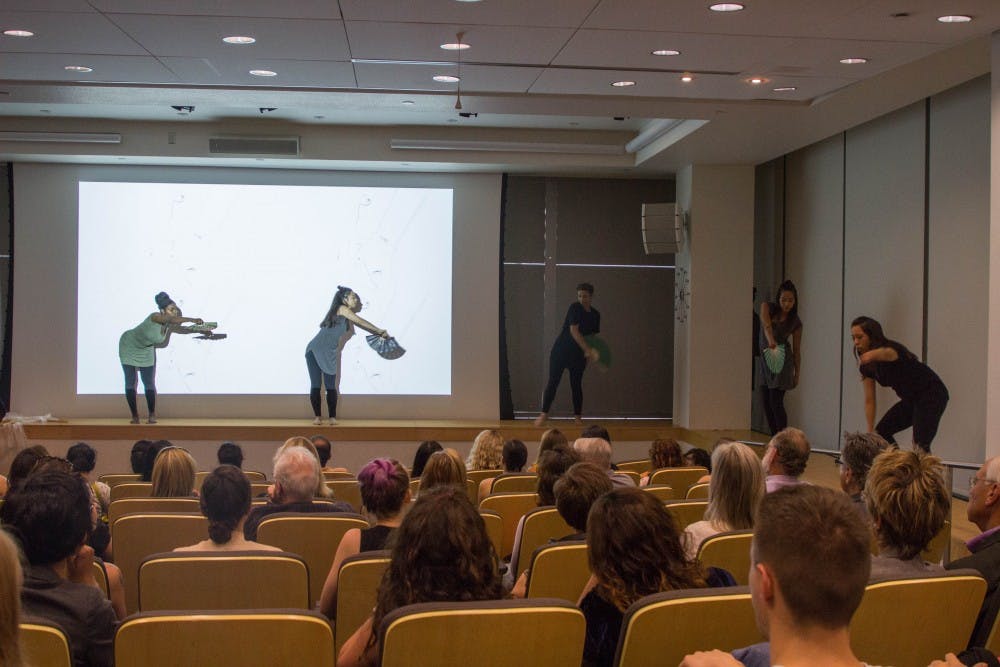Two ASU institute's collaboration between performers and scientists brought together two fields that traditionally do not overlap for an expression of research through art.
For the second year in a row, the Herberger Institute for Design and the Arts and the Biodesign Institute combined forces for the Science Exposed showcase. The night included performances that illuminated issues such as Lyme Disease and cancer.
The performances are part of the course requirements for Institute Professor Liz Lerman's class, Animating Research. Lerman, a MacArthur genius grant recipient and celebrated performer, has run the showcase for two consecutive years.
Students in the class listen to presentations by the scientists, and then collaborate to transform research into art. This year's showcase took place in the Biodesign Institute on the evening of Wednesday, April 4.
Performances ranged from dance to spoken word to interactive experiences.
Biodesign Institute Marketing and Communications Director Dianne Price said language is a barrier for scientists to communicate to the outside world. Because scientists deal with so many technical words in their fields of work, Price decided their research should be presented in a way that would transcend language.
Molecular virologist Arvind Varsani said his experience with the showcase has inspired him to change the way he converses about his work.
"I keep constantly learning how to communicate science," Varsani said. "I have to break down what I do in such simple terms that someone who is not a scientist will understand, and that's complicated."
He said the event was a beautiful community endeavor that pushes scientists to move away from vomiting jargon, while bringing together people that might not have intersected otherwise.
Herberger Institute for Design and the Arts Dean Steven Tepper said the future lies at the intersections of different disciplines.
"Our vision is that wherever we are trying to advance ideas in the world, that there are artists and designers that are intricately and intimately engaged in that work," Tepper said. "We need that in the world."
Tepper said he hopes that one day, artists, humanists and designers will be embedded in labs throughout the University.
"ASU could be the first institution to declare to the world that we believe so powerfully in these interconnections, that we're going to commit to that objective," Tepper said.
Carlo Maley, a biologist at ASU who was participating in his showcase, said he was inspired by Tepper's speech to contribute new ideas through the collaborative process of working with the artists.
"It was important to us to have as much collaboration and time together as possible, and that ended up being about every other week meeting together, both one-on-one and also with my lab group," Maley said. "For me, a lot of what's fun in science is bouncing ideas off each other, so to be able to do that with people outside of my field is also great."
Maley's work with cancer studies shows how different organisms, such as elephants, have evolved to react differently to the illness and can even kill the disease within their bodies.
"I recognize that it's only about two months of work from the start of the class until the performance, so it's not like you can produce a Broadway musical in that time," Maley said. "So many of them had so much heart in it, and I thought that was the right path to really get impact and to make it personal and emotional."
Junior dance major Tremayne Manahane and Herberger grad student Neda Movahed's reinterpretation appealed to the humanity of the research. Their piece, Conversing with Cancer, involved speeches, audience interaction and an installation featuring pictures of cancer victims.
As someone whose maternal grandparents passed away from cancer, Manahane tried to re-examine the disease through a new lens while bringing a human element to the research.
"Whatever sparked our interest or would be most challenging, we decided we wanted to partner up with and we would decide who would be the best fit," Manahane said of choosing a researcher to work with. "In the research with (Maley) and his team, I'll never forget his presentation ... He said we have to rethink cancer."
School of Molecular Sciences graduate researcher Karie Robertson's performance was already intensely personal. She worked with Herberger dance junior Tatiana Jacques to tell the story of her struggle with Lyme Disease and how it inspired her to become the first researcher at the lab to study the disease.
Jacques said she was impressed with Robertson's dance movements for the piece, and she was surprised by the results of their collaboration.
"I shouldn't be alive right now, like three times," Robertson said. "I'm happy about what I'm able to accomplish."
Jacques hopes to potentially further develop the piece for her capstone dance project and to continue working with Robertson.
"The purpose of this work is to add ideas to the world," Tepper said. "To add ideas that have not been thought or expressed before, and to recognize that when ... we really commit to that sense of inquiry, that we will advance ideas that we could not have predicted before."
Reach the reporter at sabine.galvis@asu.edu or follow @sabinegalvis on Twitter.
Like The State Press on Facebook and follow @statepress on Twitter.




